Worldwide Research Trends in Agrivoltaic Systems—A Bibliometric Review
Abstract
1. Introduction
2. Materials and Methods
2.1. Research Strategy and Study Selection Criteria
Eligibility Criteria
2.2. Data Extraction
2.3. Bibliometric Analysis
3. Results
3.1. Descriptive Statistical Analysis of the Research Literature
3.1.1. Emerging Trends in the Literature on Agrivoltaic Systems
3.1.2. Top 10 Most Relevant Journals
3.1.3. Distribution of Production by Countries and Authors
- Dupraz et al. (2011) [39], with 256 citations. The top-cited paper by Dupraz et al. [39] first proposed to designate the combination of solar panels and food crops in the same field as an agrovoltaic system. The researchers contrasted the relatively low intrinsic efficiency of the photosynthetic process (around 3%) with the average yield of commercially available monocrystalline photovoltaic (PV) solar cells (~15%) and estimated global land productivity increases of 35% and 73% for two different system designs. From an economic point of view, the authors predicted the land equivalent ratio (LER) of agrivoltaic systems, and the results were impressive. A value of 1.7 LER would mean the following, related to the productivity of land: a 100-ha farm would produce as much green energy and crops altogether as a 170-ha farm, when it is used independently for photovoltaic energy production and food crops.
- In relative terms (weighted citation of an article by the number of years), TC per year, the top three articles, with an average of over 20 citations, are:
- Among the publications, only the techno-economic side was researched by Schindele et al.(2020) [20], comparing the additional investment cost of agrivoltaic system and ground-mounted photovoltaic (PV-GM) system and both systems considered a reference to a land plot of two hectares. The total investment cost of AV amounts €1,343,846, and for PV-GM, €1,031,042. Cost factors that include PV models, installation, site preparation, and soil protection have relatively higher investment cost for AVSs. This is a very important study because APV represents a major source of economic analysis within agrivoltaic systems.
- Amaducci et al. (2018) [24] discovered that the productivity of land using agrivoltaic system can be doubled with APV over the separate production of maize and GM-PV modules. However, radiation available to the crop during APV is reduced by about 15–40%. These light conditions correspond to moderate shading which means that the amount of radiation available under an APV array depends more on the density of the panels than on the panel mobility. Authors found that growing corn under agrivoltaic systems in non-irrigated conditions can decrease soil evaporation, reduce crop losses in dry years and increase the average yield.
- Dupraz et al. (2011) [39] has an index of Total Citation per Year of around 21.33%.
3.1.4. Keywords Dynamics
3.2. Thematic Analysis and Evolution
- Themes in the upper-right quadrant are known as the motor themes, characterized by high centrality and high density, meaning that they are developed and important for the research field;
- Themes in the lower-right quadrant are known as basic and transversal themes, characterized by high centrality and low density, meaning that these themes are important for a domain, and they concern general topics transversal to the different research areas of the field;
- Themes in the lower-left quadrant are known as emerging or declining themes, with low centrality and low density, meaning that they are weakly developed and marginal;
- Themes in the upper-left quadrant are known as the highly developed and isolated themes, with well-developed internal links (high density) but unimportant external links (low centrality), meaning that they are of limited importance for the field.
4. Discussion
5. Conclusions
Supplementary Materials
Author Contributions
Funding
Data Availability Statement
Conflicts of Interest
Abbreviations
| SLR | Systematic literature review |
| AV | Agrivoltaic |
| APV | Agrophotovoltaic |
| AVSs | Agrivoltaic systems |
| Agri-PV | agrivoltaics |
| PV | Photovoltaic |
| AVS-1 | single raw PV array |
| GM-PV | Ground-mounted photovoltaic |
| NREL | National Renewable Energy Laboratory |
| LCOE | Levelized cost of electricity |
| NPV | Net present value |
| CAPEX | Capital expenditure |
| OPEX | Operating expenditure |
| OPV | Organic Photovoltaic |
| DSSC | Dye sensitized solar cell |
| c-Si | Crystalline Silicon |
Appendix A
Academic Literature Search
| Number of Key Words | Keywords Selected |
|---|---|
| KW1 | (TITLE-ABS-KEY (agrivoltaic) OR TITLE-ABS-KEY (agrovoltaic) OR TITLE-ABS-KEY (agrophotovoltaic) OR TITLE-ABS-KEY (agriphotovoltaic) OR TITLE-ABS-KEY (“agro-PV”) OR TITLE-ABS-KEY (“agri-PV”) OR TITLE-ABS-KEY (“Photovoltaic farming”) OR TITLE-ABS-KEY (“Photovoltaic agriculture”) OR TITLE-ABS-KEY (“Solar farming”)) AND (LIMIT-TO (DOCTYPE, “ar”) OR LIMIT-TO (DOCTYPE, “re”) OR LIMIT-TO (DOCTYPE, “cp”) OR LIMIT-TO (DOCTYPE, “ch”)) AND (EXCLUDE (DOCTYPE, “re”) OR EXCLUDE (DOCTYPE, “ch”)) |
| KW2 | (TITLE-ABS-KEY (agrivoltaic) OR TITLE-ABS-KEY (agrovoltaic) OR TITLE-ABS-KEY (agrophotovoltaic) OR TITLE-ABS-KEY (agriphotovoltaic) AND ALL (technical) OR ALL (infrastructural) OR ALL (environmental)) AND (EXCLUDE (DOCTYPE, “re”) OR EXCLUDE (DOCTYPE, “cr”) OR EXCLUDE (DOCTYPE, “bk”)) |
| KW3 | (TITLE-ABS-KEY (agrivoltaic) OR TITLE-ABS-KEY (agrovoltaic) OR TITLE-ABS-KEY (agrophotovoltaic) OR TITLE-ABS-KEY (agriphotovoltaic) AND ALL (agriculture) OR ALL (“agriculture activity”) OR ALL (“agriculture practice”)) AND (EXCLUDE (DOCTYPE, “re”) OR EXCLUDE (DOCTYPE, “bk”) OR EXCLUDE (DOCTYPE, “ch”)) |
| KW4 | (TITLE-ABS-KEY (agrivoltaic) OR TITLE-ABS-KEY (agrovoltaic) OR TITLE-ABS-KEY (agrophotovoltaic) OR TITLE-ABS-KEY (agriphotovoltaic) AND ALL (“high mounted”) OR ALL (“Dual-Axis Tracking”) OR ALL (“Single-Axis Tracking”) OR ALL (“Vertical PV”)) AND (EXCLUDE (DOCTYPE, “re”)) |
| KW5 | (TITLE-ABS-KEY (agrivoltaic) OR TITLE-ABS-KEY (agrovoltaic) OR TITLE-ABS-KEY (agrophotovoltaic) OR TITLE-ABS-KEY (agriphotovoltaic) AND TITLE-ABS-KEY (“economic viability”) OR TITLE-ABS-KEY (economic) OR ALL (“economic feasibility”) OR ALL (“economic benefit”) OR ALL (cost) OR ALL (investment)) AN (EXCLUDE (DOCTYPE, “cr”) OR EXCLUDE (DOCTYPE, “bk”) OR EXCLUDE (DOCTYPE, “ch”) OR EXCLUDE (DOCTYPE, “sh”)) |
| Filters | Language: English Sectors: agrivoltaic of economics, technical, infrastructure, environment, energy, and agriculture Country: All countries in the World Type: journal articles and conference paper |
References
- United Nations Global Impact of War in Ukraine: Energy Crisis. Available online: https://unsdg.un.org/sites/default/files/2022-08/GCRG_3rd-Brief_Aug3_2022_pdf (accessed on 13 November 2022).
- Global Impact of War in Ukraine on Food, Energy and Finance Systems. Available online: https://unsdg.un.org/sites/default/files/2022-04/UN (accessed on 13 November 2022).
- Dinesh, H.; Pearce, J.M. The Potential of Agrivoltaic Systems. Renew. Sustain. Energy Rev. 2016, 54, 299–308. [Google Scholar] [CrossRef]
- Weselek, A.; Ehmann, A.; Zikeli, S.; Lewandowski, I.; Schindele, S.; Högy, P. Agrophotovoltaic Systems: Applications, Challenges, and Opportunities. A Review. Agron. Sustain. Dev. 2019, 39, 35. [Google Scholar] [CrossRef]
- Huang, K.; Shu, L.; Li, K.; Yang, F.; Han, G.; Wang, X.; Pearson, S. Photovoltaic Agricultural Internet of Things towards Realizing the next Generation of Smart Farming. IEEE Access 2020, 8, 76300–76312. [Google Scholar] [CrossRef]
- Weselek, A.; Bauerle, A.; Hartung, J.; Zikeli, S.; Lewandowski, I.; Högy, P. Agrivoltaic System Impacts on Microclimate and Yield of Different Crops within an Organic Crop Rotation in a Temperate Climate. Agron. Sustain. Dev. 2021, 41, 59. [Google Scholar] [CrossRef]
- Agrivoltaics. Available online: https://www.ise.fraunhofer.de/en/key-topics/integrated-photovoltaics/agrivoltaics.html (accessed on 8 September 2022).
- Goetzberger, A.; Zastrow, A. On the Coexistence of Solar-Energy Conversion and Plant Cultivation. Int. J. Sol. Energy 1982, 1, 55–69. [Google Scholar] [CrossRef]
- Mead, R.; Willey, R.W. The Concept of a ‘Land Equivalent Ratio’ and Advantages in Yields from Intercropping. Exp. Agric. 1980, 16, 217–228. [Google Scholar] [CrossRef]
- The Solar Energy Society Survey of Research on Applications of Solar Energy to Agriculture, Horticulture, Animal Husbandry, and Forest Products. Sol. Energy 1965, 9, 87–94. [CrossRef]
- Makhkamov, K.; Trukhov, V.; Orunov, B.; Korobkov, A.; Lejebokov, A.; Tursunbaev, I.; Orda, E.; Chuvichkin, V.; Yudin, G.; Muhamediev, E.; et al. Development of Solar and Micro Co-Generation Power Installations on the Basis of Stirling Engines. In Proceedings of the Collection of Technical Papers—35th Intersociety Energy Conversion Engineering Conference and Exhibit (IECEC) (Cat. No.00CH37022), Las Vegas, NV, USA, 24–28 July 2000. [Google Scholar]
- Gorjian, S.; Singh, R.; Shukla, A.; Mazhar, A.R. On-Farm Applications of Solar PV Systems. In Photovoltaic Solar Energy Conversion; Elsevier: Amsterdam, The Netherlands, 2020; pp. 147–190. ISBN 9780128196106. [Google Scholar]
- Gorjian, S.; Shukla, A. (Eds.) Photovoltaic Solar Energy Conversion; Academic Press: San Diego, CA, USA, 2020; ISBN 9780128196106. [Google Scholar]
- Pascaris, A.S.; Schelly, C.; Burnham, L.; Pearce, J.M. Integrating Solar Energy with Agriculture: Industry Perspectives on the Market, Community, and Socio-Political Dimensions of Agrivoltaics. Energy Res. Soc. Sci. 2021, 75, 102023. [Google Scholar] [CrossRef]
- Valle, B.; Simonneau, T.; Sourd, F.; Pechier, P.; Hamard, P.; Frisson, T.; Ryckewaert, M.; Christophe, A. Increasing the Total Productivity of a Land by Combining Mobile Photovoltaic Panels and Food Crops. Appl. Energy 2017, 206, 1495–1507. [Google Scholar] [CrossRef]
- Hassanpour Adeh, E.; Selker, J.S.; Higgins, C.W. Remarkable Agrivoltaic Influence on Soil Moisture, Micrometeorology and Water-Use Efficiency. PLoS ONE 2018, 13, e0203256. [Google Scholar] [CrossRef]
- Campana, P.E.; Stridh, B.; Amaducci, S.; Colauzzi, M. Optimisation of Vertically Mounted Agrivoltaic Systems. J. Clean. Prod. 2021, 325, 129091. [Google Scholar] [CrossRef]
- Malu, P.R.; Sharma, U.S.; Pearce, J.M. Agrivoltaic Potential on Grape Farms in India. Sustain. Energy Technol. Assessments 2017, 23, 104–110. [Google Scholar] [CrossRef]
- Wang, L.; Li, Y. Research on Niche Improvement Path of Photovoltaic Agriculture in China. Int. J. Environ. Res. Public Health 2022, 19, 13087. [Google Scholar] [CrossRef]
- Schindele, S.; Trommsdorff, M.; Schlaak, A.; Obergfell, T.; Bopp, G.; Reise, C.; Braun, C.; Weselek, A.; Bauerle, A.; Högy, P.; et al. Implementation of Agrophotovoltaics: Techno-Economic Analysis of the Price-Performance Ratio and Its Policy Implications. Appl. Energy 2020, 265, 16. [Google Scholar] [CrossRef]
- Kim, S.; Kim, Y.; On, Y.; So, J.; Yoon, C.-Y.; Kim, S. Hybrid Performance Modeling of an Agrophotovoltaic System in South Korea. Energies 2022, 15, 6512. [Google Scholar] [CrossRef]
- Gonocruz, R.A.; Uchiyama, S.; Yoshida, Y. Modeling of Large-Scale Integration of Agrivoltaic Systems: Impact on the Japanese Power Grid. J. Clean. Prod. 2022, 363, 132545. [Google Scholar] [CrossRef]
- Evans, M.E.; Langley, J.A.; Shapiro, F.R.; Jones, G.F. A Validated Model, Scalability, and Plant Growth Results for an Agrivoltaic Greenhouse. Sustainability 2022, 14, 6154. [Google Scholar] [CrossRef]
- Amaducci, S.; Yin, X.; Colauzzi, M. Agrivoltaic Systems to Optimise Land Use for Electric Energy Production. Appl. Energy 2018, 220, 545–561. [Google Scholar] [CrossRef]
- Marrou, H.; Wery, J.; Dufour, L.; Dupraz, C. Productivity and Radiation Use Efficiency of Lettuces Grown in the Partial Shade of Photovoltaic Panels. Eur. J. Agron. 2013, 44, 54–66. [Google Scholar] [CrossRef]
- Basile, B.; Romano, R.; Giaccone, M.; Barlotti, E.; Colonna, V.; Cirillo, C.; Shahak, Y.; Forlani, M. Use of Photo-Selective Nets for Hail Protection of Kiwifruit Vines in Southern Italy. Acta Hortic. 2008, 770, 185–192. [Google Scholar] [CrossRef]
- Jiang, S.; Tang, D.; Zhao, L.; Liang, C.; Cui, N.; Gong, D.; Wang, Y.; Feng, Y.; Hu, X.; Peng, Y. Effects of Different Photovoltaic Shading Levels on Kiwifruit Growth, Yield and Water Productivity under “Agrivoltaic” System in Southwest China. Agric. Water Manag. 2022, 269, 107675. [Google Scholar] [CrossRef]
- Claudia Hanisch, M.A. Communications. First Agrivoltaic System for Carbon-Neutral Orcharding Being Tested. Available online: https://www.ise.fraunhofer.de/content/dam/ise/en/documents/press-releases/2021/2121_ISE_e_PR_Agri_PV_Orcharding.pdf (accessed on 13 November 2022).
- Juillion, P.; Lopez, G.; Fumey, D.; Lesniak, V.; Génard, M.; Vercambre, G. Shading Apple Trees with an Agrivoltaic System: Impact on Water Relations, Leaf Morphophysiological Characteristics and Yield Determinants. SSRN Electron. J. 2022, 306, 111434. [Google Scholar] [CrossRef]
- Gim, G.H.; Park, J.; Young Kim, T.; Deok, S.; Kim, W.; Nam, J.; Lim, C. Investigation of Pear Growth under Foldable Agrivoltaic Structure. Available online: https://www.agrisolarclearinghouse.org/wp-content/uploads/2022/02/Investigation-of-Pear-Growth-Under-Foldable-Agrivoltaic-Structure.pdf (accessed on 8 November 2022).
- Bellini, E. Agrivoltaics for Pear Orchards. Available online: https://www.pv-magazine.com/2020/10/02/agrivoltaics-for-pear-orchards/ (accessed on 8 November 2022).
- Cossu, M.; Yano, A.; Solinas, S.; Deligios, P.A.; Tiloca, M.T.; Cossu, A.; Ledda, L. Agricultural Sustainability Estimation of the European Photovoltaic Greenhouses. Eur. J. Agron. 2020, 118, 126074. [Google Scholar] [CrossRef]
- Barron-Gafford, G.A.; Pavao-Zuckerman, M.A.; Minor, R.L.; Sutter, L.F.; Barnett-Moreno, I.; Blackett, D.T.; Thompson, M.; Dimond, K.; Gerlak, A.K.; Nabhan, G.P.; et al. Agrivoltaics Provide Mutual Benefits across the Food–Energy–Water Nexus in Drylands. Nat. Sustain. 2019, 2, 848–855. [Google Scholar] [CrossRef]
- Beck, M.; Bopp, G.; Goetzberger, A.; Obergfell, T.; Reise, C.; Schindele, S. Combining PV and Food Crops to Agrophotovoltaic—Optimization of Orientation and Harvest. In Proceedings of the 27th European Photovoltaic Solar Energy Conference and Exhibition, EU PVSEC, Frankfurt, Germany, 24–28 September 2012; pp. 4096–4100. [Google Scholar] [CrossRef]
- Weselek, A.; Bauerle, A.; Zikeli, S.; Lewandowski, I.; Högy, P. Effects on Crop Development, Yields and Chemical Composition of Celeriac (Apium Graveolens L. Var. Rapaceum) Cultivated Underneath an Agrivoltaic System. Agronomy 2021, 11, 733. [Google Scholar] [CrossRef]
- Sekiyama, T.; Nagashima, A. Solar Sharing for Both Food and Clean Energy Production: Performance of Agrivoltaic Systems for Corn, A Typical Shade-Intolerant Crop. Environments 2019, 6, 65. [Google Scholar] [CrossRef]
- Zisis, C.; Pechlivani, E.M.; Tsimikli, S.; Mekeridis, E.; Laskarakis, A.; Logothetidis, S. Organic Photovoltaics on Greenhouse Rooftops: Effects on Plant Growth. Mater. Today 2019, 19, 65–72. [Google Scholar] [CrossRef]
- Moreda, G.P.; Muñoz-García, M.A.; Alonso-García, M.C.; Hernández-Callejo, L. Techno-Economic Viability of Agro-Photovoltaic Irrigated Arable Lands in the EU-Med Region: A Case-Study in Southwestern Spain. Agronomy 2021, 11, 593. [Google Scholar] [CrossRef]
- Dupraz, C.; Marrou, H.; Talbot, G.; Dufour, L.; Nogier, A.; Ferard, Y. Combining Solar Photovoltaic Panels and Food Crops for Optimising Land Use: Towards New Agrivoltaic Schemes. Renew. Energy 2011, 36, 2725–2732. [Google Scholar] [CrossRef]
- Ravi, S.; Lobell, D.B.; Field, C.B. Tradeoffs and Synergies between Biofuel Production and Large Solar Infrastructure in Deserts. Environ. Sci. Technol. 2014, 48, 3021–3030. [Google Scholar] [CrossRef]
- Othman, N.F.; Ya’acob, M.E.; Abdul-Rahim, A.S.; Shahwahid Othman, M.; Radzi, M.A.M.; Hizam, H.; Wang, Y.D.; Ya’acob, A.M.; Jaafar, H.Z.E. Embracing New Agriculture Commodity through Integration of Java Tea as High Value Herbal Crops in Solar PV Farms. J. Clean. Prod. 2015, 91, 71–77. [Google Scholar] [CrossRef]
- Majumdar, D.; Pasqualetti, M.J. Dual Use of Agricultural Land: Introducing ‘Agrivoltaics’ in Phoenix Metropolitan Statistical Area, USA. Landsc. Urban Plan. 2018, 170, 150–168. [Google Scholar] [CrossRef]
- Elamri, Y.; Cheviron, B.; Lopez, J.-M.; Dejean, C.; Belaud, G. Water Budget and Crop Modelling for Agrivoltaic Systems: Application to Irrigated Lettuces. Agric. Water Manag. 2018, 208, 440–453. [Google Scholar] [CrossRef]
- Fu, X.Q.; Yang, D.C.; Guo, Q.L.; Sun, H.B. Security Analysis of a Park-Level Agricultural Energy Network Considering Agrometeorology and Energy Meteorology. Csee J. Power Energy Syst. 2020, 6, 743–748. [Google Scholar] [CrossRef]
- Maia, A.S.C.; de Andrade Culhari, E.; de França Carvalho Fonsêca, V.; Milan, H.F.M.; Gebremedhin, K.G. Photovoltaic Panels as Shading Resources for Livestock. J. Clean. Prod. 2020, 258, 120551. [Google Scholar] [CrossRef]
- Andrew, A.C.; Higgins, C.W.; Smallman, M.A.; Graham, M.; Ates, S. Herbage Yield, Lamb Growth and Foraging Behavior in Agrivoltaic Production System. Front. Sustain. Food Syst. 2021, 5, 659175. [Google Scholar] [CrossRef]
- Bellini, E. Agrivoltaics Increases Land Productivity, Improves Animal Welfare. Available online: https://www.pv-magazine.com/2021/04/30/agrivoltaics-increases-land-productivity-improves-animal-welfare/ (accessed on 8 November 2022).
- Ma, Y.H. Techno-Economic Analysis of Agrivoltaics Installations for Greenhouses in Sweden. Master’s Thesis, Escola Tècnica Superior d’Enginyeria Industrial de Barcelona, Barcelona, Spain, 2022. [Google Scholar]
- Fu, X.; Zhou, Y. Collaborative Optimization of PV Greenhouses and Clean Energy Systems in Rural Areas. IEEE Trans. Sustain. Energy 2022, 14, 642–656. [Google Scholar] [CrossRef]
- Mamun, M.A.A.; Dargusch, P.; Wadley, D.; Zulkarnain, N.A.; Aziz, A.A. A Review of Research on Agrivoltaic Systems. Renew. Sustain. Energy Rev. 2022, 161, 112351. [Google Scholar] [CrossRef]
- Willockx, B.; Herteleer, B.; Ronsijn, B.; Uytterhaegen, B.; Cappelle, J. A Standardized Classification and Performance Indicators of Agrivoltaic Systems. EU PVSEC Proc. 2020, 1995–1998. [Google Scholar] [CrossRef]
- Honrubia-Escribano, A.; Ramirez, F.J.; Gómez-Lázaro, E.; Garcia-Villaverde, P.M.; Ruiz-Ortega, M.J.; Parra-Requena, G. Influence of Solar Technology in the Economic Performance of PV Power Plants in Europe. A Comprehensive Analysis. Renew. Sustain. Energy Rev. 2018, 82, 488–501. [Google Scholar] [CrossRef]
- Ameur, A.; Berrada, A.; Loudiyi, K.; Aggour, M. Forecast Modeling and Performance Assessment of Solar PV Systems. J. Clean. Prod. 2020, 267, 122167. [Google Scholar] [CrossRef]
- La Notte, L.; Giordano, L.; Calabrò, E.; Bedini, R.; Colla, G.; Puglisi, G.; Reale, A. Hybrid and Organic Photovoltaics for Greenhouse Applications. Appl. Energy 2020, 278, 115582. [Google Scholar] [CrossRef]
- Fernández, E.F.; Villar-Fernández, A.; Montes-Romero, J.; Ruiz-Torres, L.; Rodrigo, P.M.; Manzaneda, A.J.; Almonacid, F. Global Energy Assessment of the Potential of Photovoltaics for Greenhouse Farming. Appl. Energy 2022, 309, 118474. [Google Scholar] [CrossRef]
- Best Research-Cell Efficiency Chart. Available online: https://www.nrel.gov/pv/cell-efficiency.html (accessed on 19 July 2022).
- Global Benchmark Capex for Utility-Scale Solar PV 2010–2020. Available online: https://www.statista.com/statistics/971982/solar-pv-capex-worldwide-utility-scale/ (accessed on 11 November 2022).
- Trommsdorff, M. An Economic Analysis of Agrophotovoltaics: Opportunities, Risks and Strategies towards a More Efficient Land Use. Available online: https://www.wipo.uni-freiburg.de/CENworkpapers-en/files/cen-paper-03-2016trommsdorff.pdf (accessed on 11 November 2022).
- Agrivoltaics: Opportunities for Agriculture and the Energy Transition. Available online: https://www.ise.fraunhofer.de/content/dam/ise/en/documents/publications/studies/APV-Guideline.pdf (accessed on 4 July 2022).
- Poonia, S.; Jat, N.K.; Santra, P.; Singh, A.K.; Jain, D.; Meena, H.M. Techno-Economic Evaluation of Different Agri-Voltaic Designs for the Hot Arid Ecosystem India. Renew. Energy 2022, 184, 149–163. [Google Scholar] [CrossRef]
- Agostini, A.; Colauzzi, M.; Amaducci, S. Innovative Agrivoltaic Systems to Produce Sustainable Energy: An Economic and Environmental Assessment. Appl. Energy 2021, 281, 116102. [Google Scholar] [CrossRef]
- Trommsdorff, M.; Vorast, M.; Durga, N.; Padwardhan, S.M. Potential of Agrivoltaics to Contribute to Socio-Economic Sustainability: A Case Study in Maharashtra/India. In Proceedings of the AIP Conference Proceedings; AIP Publishing: Melville, NY, USA, 2021. [Google Scholar]
- Willockx, B.; Lavaert, C.; Cappelle, J. Geospatial Assessment of Elevated Agrivoltaics on Arable Land in Europe to Highlight the Implications on Design, Land Use and Economic Level. Energy Rep. 2022, 8, 8736–8751. [Google Scholar] [CrossRef]
- Bellardo, T. The Use of Co-Citations to Study Science. Libr. Res. 1980, 2, 231–237. [Google Scholar]
- Pritchard, A. Statistical Bibliography or Bibliometrics. J. Doc. 1969, 25, 348. [Google Scholar]
- Broadus, R.N. Toward a Definition of “Bibliometrics”. Scientometrics 1987, 12, 373–379. [Google Scholar] [CrossRef]
- Peters, H.P.F.; Van Raan, A.F.J. Structuring Scientific Activities by Co-Author Analysis. Scientometrics 1991, 20, 235–255. [Google Scholar] [CrossRef]
- Börner, K.; Chen, C.; Boyack, K.W. Visualizing Knowledge Domains. Annu. Rev. Inf. Sci. Technol. 2005, 37, 179–255. [Google Scholar] [CrossRef]
- Callon, M.; Courtial, J.-P.; Turner, W.A.; Bauin, S. From Translations to Problematic Networks: An Introduction to Co-Word Analysis. Soc. Sci. Inf. 1983, 22, 191–235. [Google Scholar] [CrossRef]
- Garfield, E. Scientography: Mapping the Tracks of Science. Curr. Contents Soc. Behav. Sci. 1994, 7, 5–10. [Google Scholar]
- Nordberg, E.J.; Julian Caley, M.; Schwarzkopf, L. Designing Solar Farms for Synergistic Commercial and Conservation Outcomes. Sol. Energy 2021, 228, 586–593. [Google Scholar] [CrossRef]
- Toledo, C.; Scognamiglio, A. Agrivoltaic Systems Design and Assessment: A Critical Review, and a Descriptive Model towards a Sustainable Landscape Vision (Three-Dimensional Agrivoltaic Patterns). Sustainability 2021, 13, 6871. [Google Scholar] [CrossRef]
- Page, M.J.; McKenzie, J.E.; Bossuyt, P.M.; Boutron, I.; Hoffmann, T.C.; Mulrow, C.D.; Shamseer, L.; Tetzlaff, J.M.; Akl, E.A.; Brennan, S.E.; et al. The PRISMA 2020 Statement: An Updated Guideline for Reporting Systematic Reviews. Syst. Rev. 2021, 10, 89. [Google Scholar] [CrossRef]
- Albarillo, F. Language in Social Science Databases: English versus Non-English Articles in JSTOR and Scopus. Behav. Soc. Sci. Librar. 2014, 33, 77–90. [Google Scholar] [CrossRef]
- From Idea to Implementation. Available online: https://agri-pv.org/en/the-concept/from-idea-to-implementation/ (accessed on 20 November 2022).
- University of Massachusetts Amherst STATE: MA. Available online: https://www.energy.gov/sites/default/files/2021-08/CX-024167.pdf (accessed on 20 November 2022).
- Liu, H.; Yin, C.; Gao, Z.; Hou, L. Evaluation of Cucumber Yield, Economic Benefit and Water Productivity under Different Soil Matric Potentials in Solar Greenhouses in North China. Agric. Water Manag. 2021, 243, 106442. [Google Scholar] [CrossRef]
- Zheng, J.; Meng, S.; Zhang, X.; Zhao, H.; Ning, X.; Chen, F.; Abaker Omer, A.A.; Ingenhoff, J.; Liu, W. Increasing the Comprehensive Economic Benefits of Farmland with Even-Lighting Agrivoltaic Systems. PLoS ONE 2021, 16, e0254482. [Google Scholar] [CrossRef]
- Renewable Energy Capacity Worldwide by Country 2021. Available online: https://www.statista.com/statistics/267233/renewable-energy-capacity-worldwide-by-country/ (accessed on 20 November 2022).
- Andrew, A.C.; Higgins, C.W.; Bionaz, M.; Smallman, M.A.; Ates, S. Pasture Production and Lamb Growth in Agrivoltaic System. In Proceedings of the AGRIVOLTAICS2020 Conference: Launching Agrivoltaics World-Wide; AIP Publishing: Melville, NY, USA, 2021. [Google Scholar]
- Shepard, L.A.; Higgins, C.W.; Proctor, K.W. Agrivoltaics: Modeling the Relative Importance of Longwave Radiation from Solar Panels. PLoS ONE 2022, 17, e0273119. [Google Scholar] [CrossRef]
- Pascaris, A.S. Examining Existing Policy to Inform a Comprehensive Legal Framework for Agrivoltaics in the U.S. Energy Policy 2021, 159, 112620. [Google Scholar] [CrossRef]
- Wang, J.; Zhang, C.; Zhang, L. Development of Photovoltaic Agriculture in China Based on SWOT Analysis. In Advances in Transdisciplinary Engineering; IOS Press: Amsterdam, The Netherlands, 2021. [Google Scholar]
- Li, B.; Ding, J.; Wang, J.; Zhang, B.; Zhang, L. Key Factors Affecting the Adoption Willingness, Behavior, and Willingness-Behavior Consistency of Farmers Regarding Photovoltaic Agriculture in China. Energy Policy 2021, 149, 112101. [Google Scholar] [CrossRef]
- Marrou, H.; Guilioni, L.; Dufour, L.; Dupraz, C.; Wery, J. Microclimate under Agrivoltaic Systems: Is Crop Growth Rate Affected in the Partial Shade of Solar Panels? Agric. For. Meteorol. 2013, 177, 117–132. [Google Scholar] [CrossRef]
- Marrou, H.; Dufour, L.; Wery, J. How Does a Shelter of Solar Panels Influence Water Flows in a Soil–Crop System? Eur. J. Agron. 2013, 50, 38–51. [Google Scholar] [CrossRef]
- Adeh, E.H.; Good, S.P.; Calaf, M.; Higgins, C.W. Solar PV Power Potential Is Greatest over Croplands. Sci. Rep. 2019, 9, 11442. [Google Scholar] [CrossRef] [PubMed]
- Dumont, O.T. From Modelmania to Datanomics: The Top Journals and the Quest for Formalization. In Proceedings of the STOREP 2018-Whatever Has Happened to Political Economy? STOREPapers, Genoa, Italy, 28–30 June 2018; pp. 5–22. [Google Scholar]
- Callon, M.; Courtial, J.P.; Laville, F. Co-Word Analysis as a Tool for Describing the Network of Interactions between Basic and Technological Research: The Case of Polymer Chemsitry. Scientometrics 1991, 22, 155–205. [Google Scholar] [CrossRef]
- Coulter, N.; Monarch, I.; Konda, S. Software Engineering as Seen through Its Research Literature: A Study in Co-Word Analysis. J. Am. Soc. Inf. Sci. 1998, 49, 1206–1223. [Google Scholar] [CrossRef]
- Cobo, M.J.; López-Herrera, A.G.; Herrera-Viedma, E.; Herrera, F. An Approach for Detecting, Quantifying, and Visualizing the Evolution of a Research Field: A Practical Application to the Fuzzy Sets Theory Field. J. Informetr. 2011, 5, 146–166. [Google Scholar] [CrossRef]
- Cahlik, T. Search for Fundamental Articles in Economics. Scientometrics 2000, 49, 389–402. [Google Scholar] [CrossRef]
- Djojodihardjo, H. Conceptual Design of a Medium-Sized Combined Smart Photovoltaic—Agriculture System—Case Study in Malaysia. MATEC Web Conf. 2016, 55, 06013. [Google Scholar] [CrossRef]
- Leon, A.; Ishihara, K.N. Assessment of New Functional Units for Agrivoltaic Systems. J. Environ. Manag. 2018, 226, 493–498. [Google Scholar] [CrossRef]
- Zainol Abidin, M.A.; Mahyuddin, M.N.; Mohd Zainuri, M.A.A. Solar Photovoltaic Architecture and Agronomic Management in Agrivoltaic System: A Review. Sustainability 2021, 13, 7846. [Google Scholar] [CrossRef]
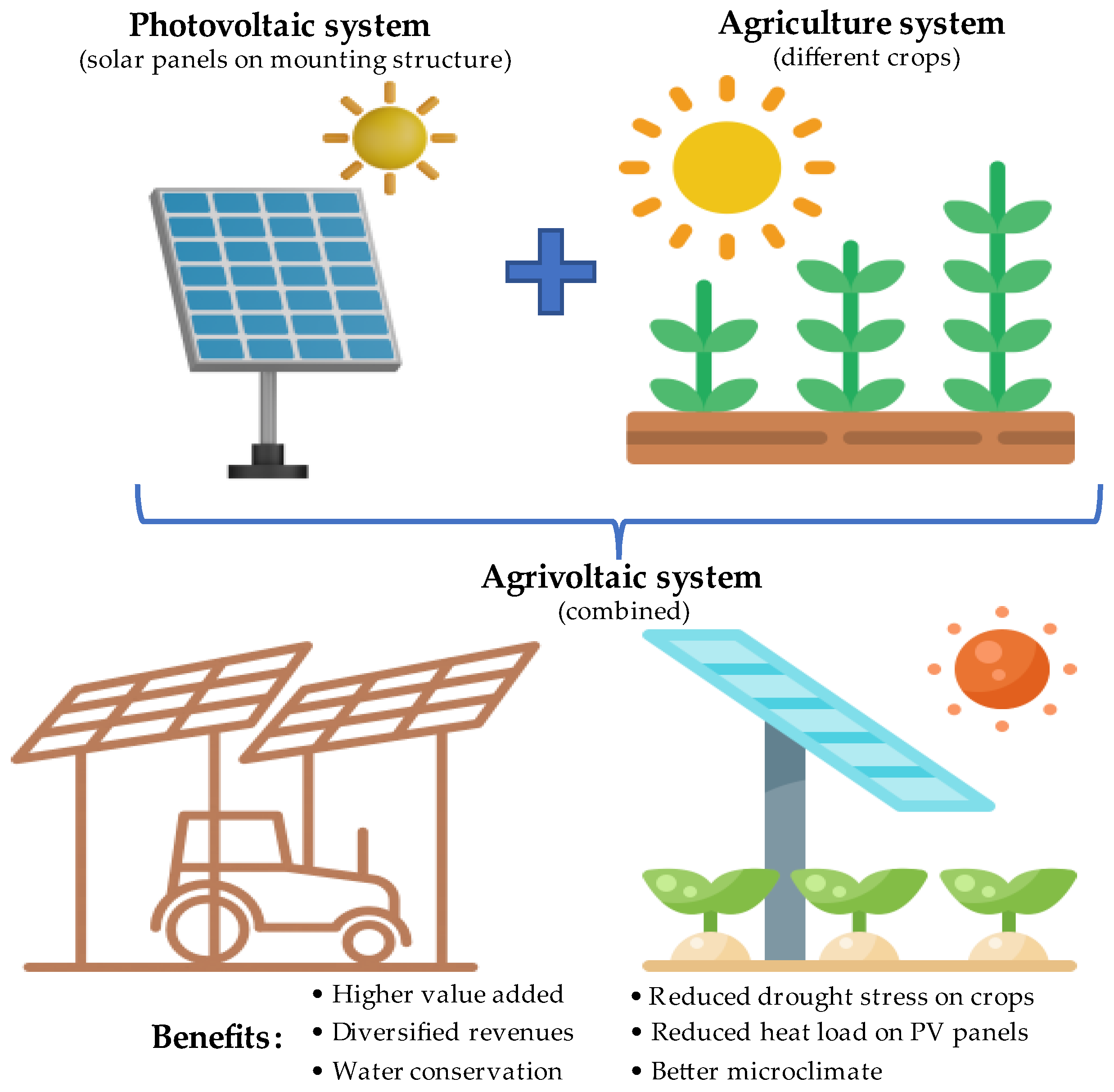
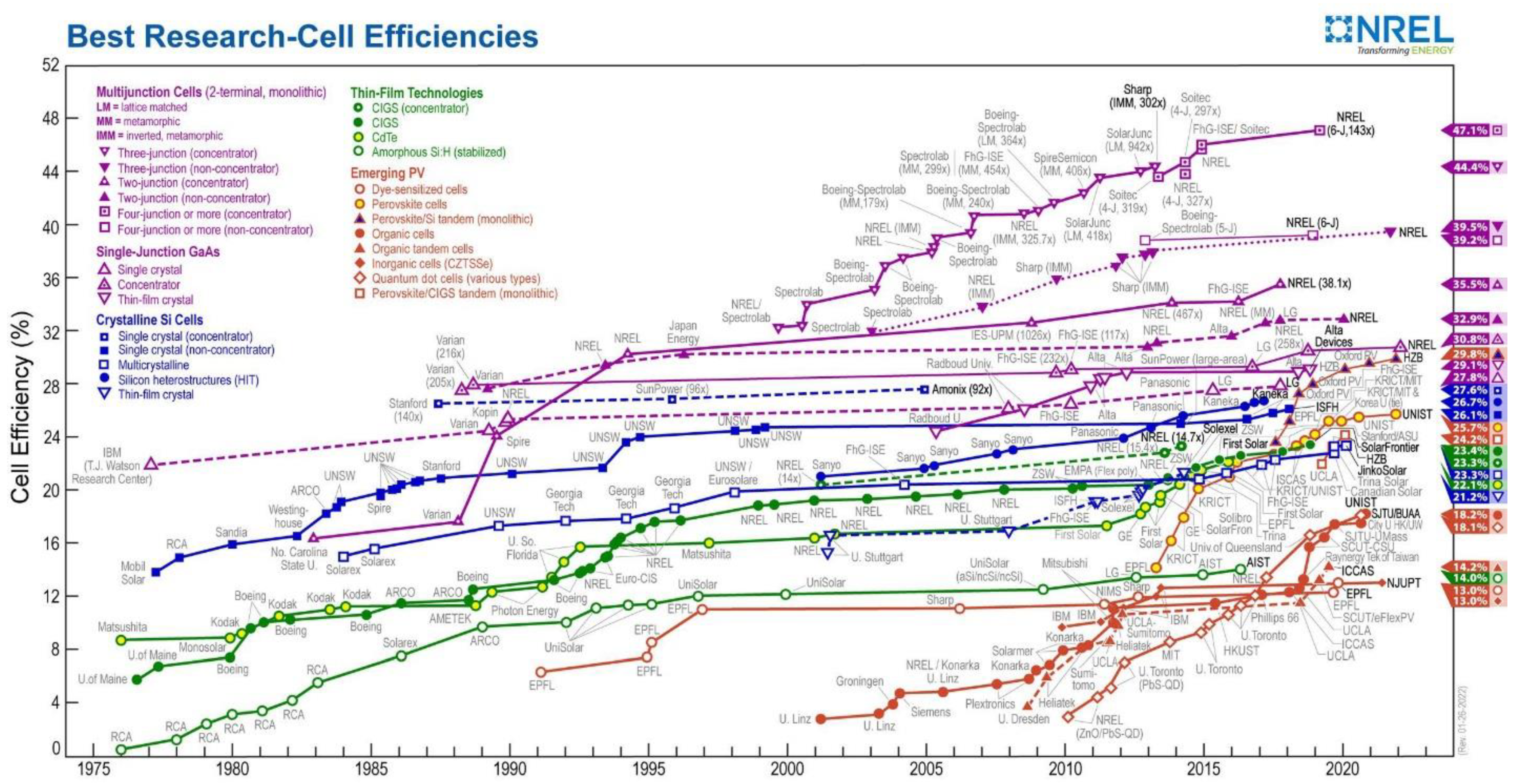
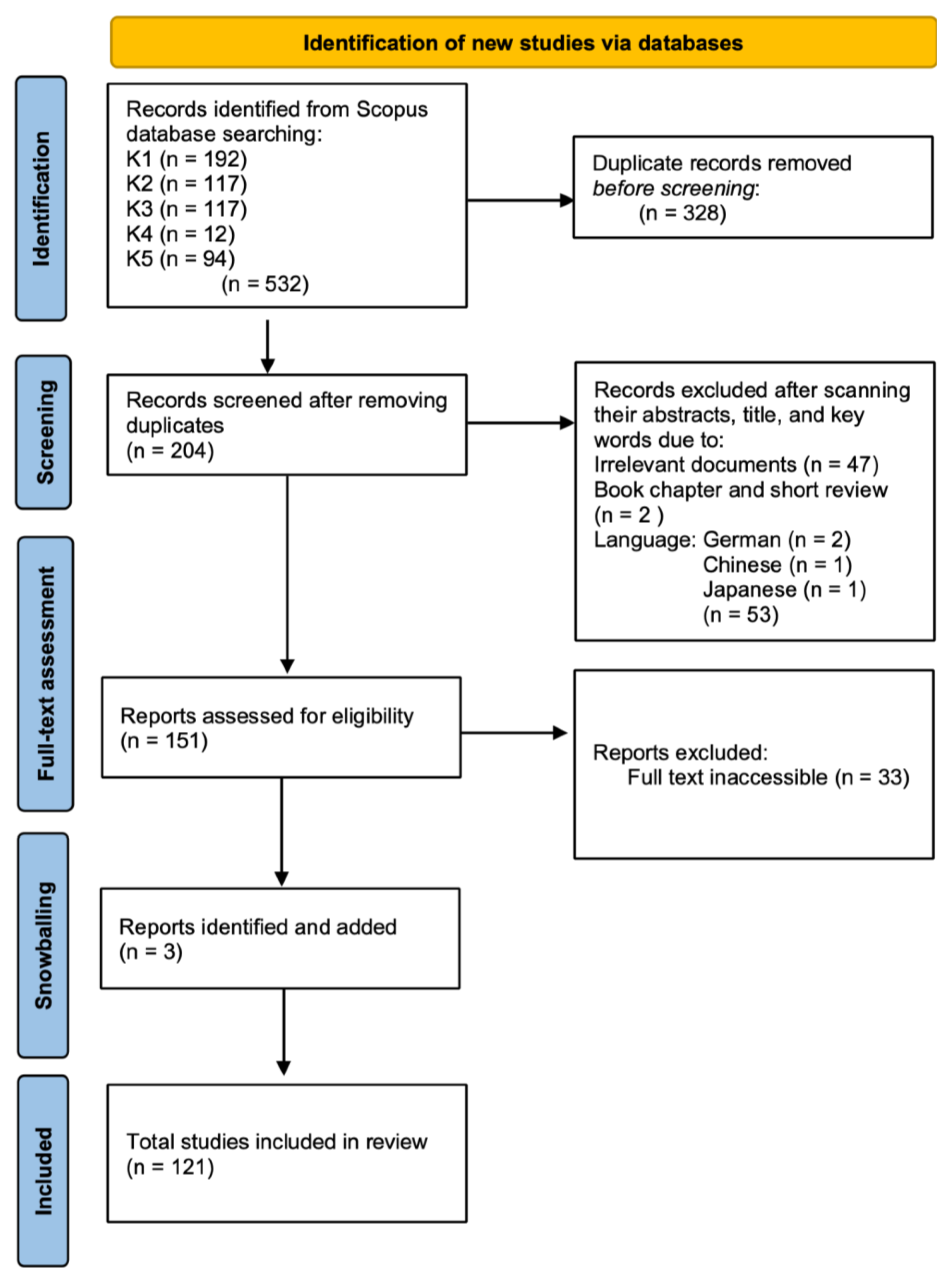
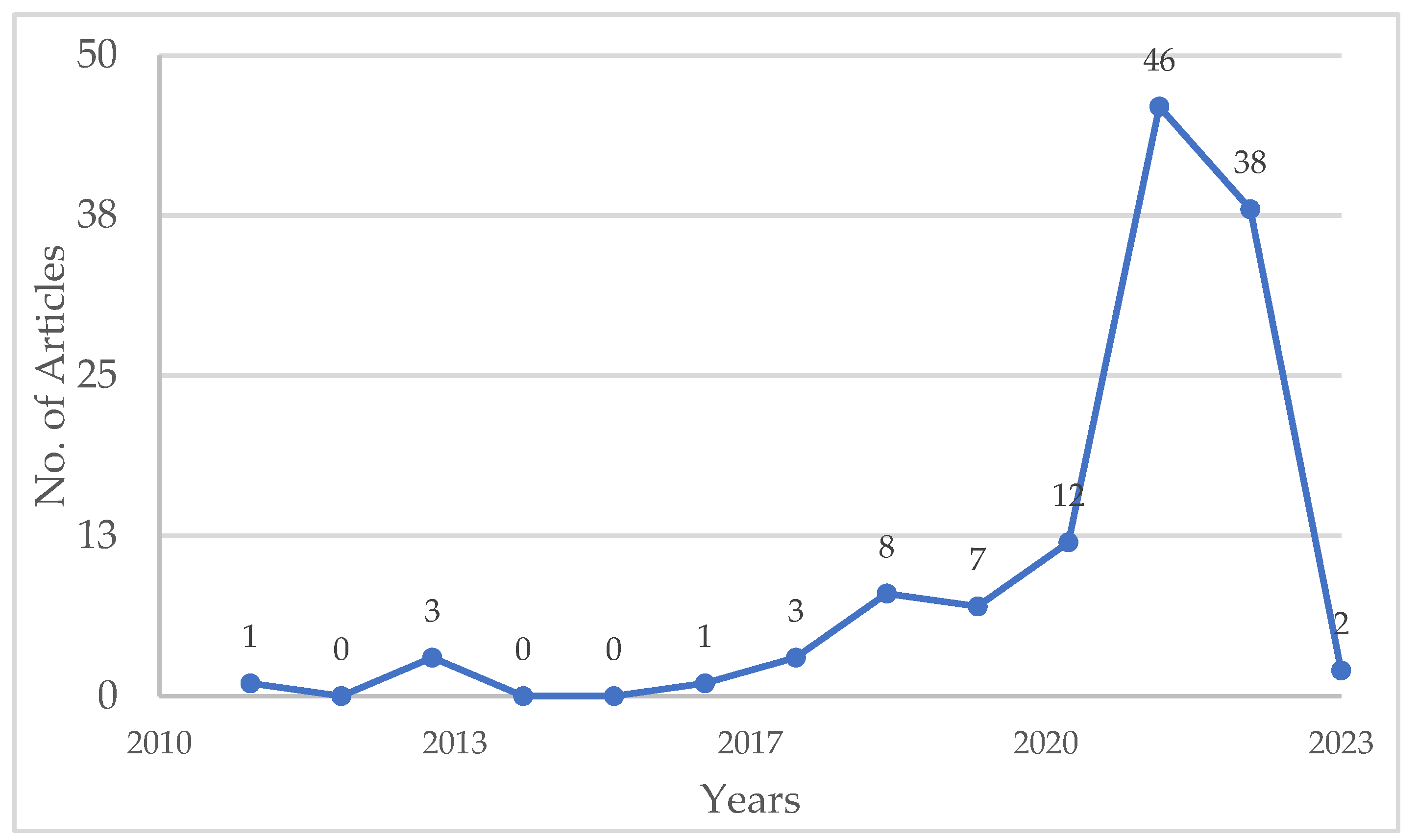


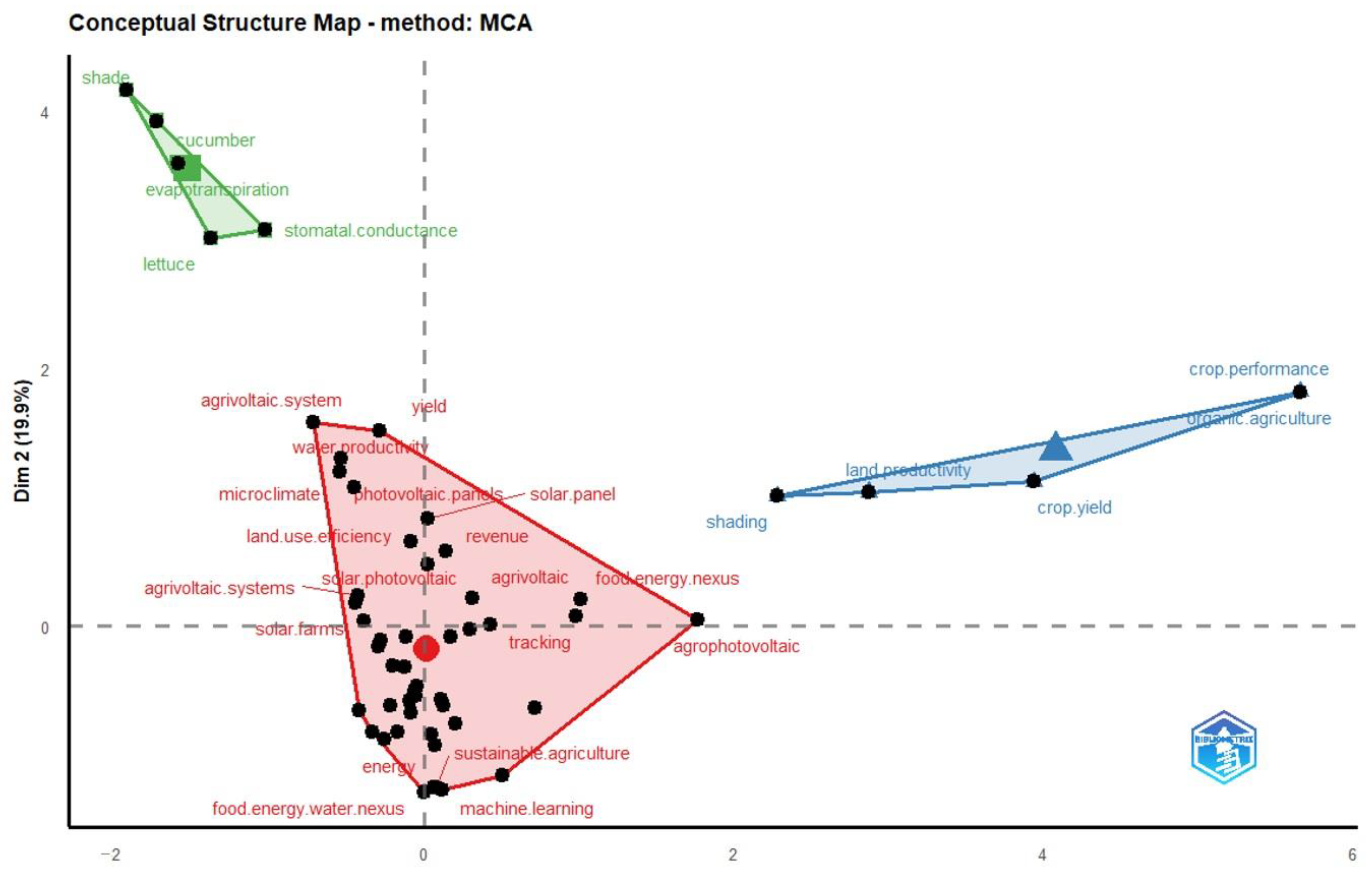
| Description | Results |
|---|---|
| Period | 2011–2023 |
| Documents | 121 |
| Sources (journals and conference papers) | 59 |
| Authors | 382 |
| References | 5415 |
| Author’s keywords | 363 |
| Journal/Proceedings | Publisher | Country | H Index | SJR | TP |
|---|---|---|---|---|---|
| AIP CONFERENCE PROCEEDINGS | American Institute of Physics | United States | 75 | 0.19 (Not yet assigned quartile) | 11 |
| APPLIED ENERGY | Elsevier | United Kingdom | 235 | 3.06 (Q1) | 9 |
| AGRONOMY | John Wiley & Sons. | United States | 138 | 0.69 (Q1) | 8 |
| ENERGIES | MDPI | Switzerland | 111 | 0.65 (Q1/Q2) | 7 |
| SUSTAINABILITY (SWITZERLAND) | MDPI | Switzerland | 109 | 0.66 (Q1/Q2) | 7 |
| IOP CONFERENCE SERIES: EARTH AND ENVIRONMENTAL SCIENCE | IOP Publishing Ltd. | United Kingdom | 34 | 0.2 (Not yet assigned quartile) | 4 |
| RENEWABLE ENERGY | Elsevier | United Kingdom | 210 | 1.88 (Q1) | 4 |
| SCIENTIFIC REPORTS | Nature Publishing Group | United Kingdom | 242 | 1.01 (Q1) | 4 |
| JOURNAL OF CLEANER PRODUCTION | Elsevier | United Kingdom | 232 | 1.92 (Q1) | 3 |
| PLOS ONE | Public Library of Science | United States | 367 | 0.85 (Q1) | 3 |
| Region | No. of Articles | Region | No. of Articles |
|---|---|---|---|
| USA | 15 | SPAIN | 4 |
| CHINA | 11 | AUSTRALIA | 3 |
| GERMANY | 9 | BELGIUM | 3 |
| FRANCE | 8 | FINLAND | 3 |
| SOUTH KOREA | 8 | PAKISTAN | 3 |
| JAPAN | 7 | NETHERLANDS | 2 |
| ITALY | 6 | SINGAPORE | 2 |
| CANADA | 5 | THAILAND | 2 |
| INDIA | 5 | TURKEY | 2 |
| MALAYSIA | 5 | UK | 2 |
| Paper | Titles | DOI | TC | TC Per Year |
|---|---|---|---|---|
| DUPRAZ C, 2011, [39], RENEW ENERGY | Combining solar photovoltaic panels and food crops for optimizing land use towards new agrivoltaic schemes | 10.1016/j.renene.2011.03.005 | 256 | 21.33 |
| MARROU H, 2013, [25], EUR J AGRON-a | Productivity and radiation use efficiency of lettuces grown in the partial shade of photovoltaic panels | 10.1016/j.eja.2012.08.003 | 143 | 14.30 |
| MARROU H, 2013, [85], AGRIC FOR METEROL | Microclimate under agrivoltaic systems is crop growth rate affected in the partial shade of solar panels | 10.1016/j.agrformet.2013.04.012 | 135 | 13.50 |
| AMADUCCI S, 2018, [24], APPL ENERGY | Agrivoltaic systems to optimize land use for electric energy production | 10.1016/j.apenergy.2018.03.081 | 117 | 23.40 |
| ADEH EH, 2018, [16], PLOS ONE | Remarkable agrivoltaic influence on soil moisture micrometeorology and wateruse efficiency | 10.1371/journal.pone.0203256 | 86 | 17.20 |
| MARROU H, 2013, [86], EUR J AGRON | How does a shelter of solar panels influence water flows in a soilcrop system | 10.1016/j.eja.2013.05.004 | 80 | 8.00 |
| SCHINDELE S, 2020, [20], APPL ENERGY | Implementation of agrophotovoltaics technoeconomic analysis of the priceperformance ratio and its policy implications | 10.1016/j.apenergy.2020.114737 | 77 | 25.67 |
| VALLE B, 2017, [15], APPL ENERGY | Increasing the total productivity of a land by combining mobile photovoltaic panels and food crops | 10.1016/j.apenergy.2017.09.113 | 75 | 12.50 |
| ADEH EH, 2019, [87], SCI REP | Solar PV power potential is greatest over croplands | 10.1038/s41598-019-47803-3 | 75 | 18.75 |
| MALU PR, 2017, [18], SUSTAINABLE ENERGY TECHNOL ASSESS | Agrivoltaic potential on grape farms in India | 10.1016/j.seta.2017.08.004 | 71 | 11.83 |
Disclaimer/Publisher’s Note: The statements, opinions and data contained in all publications are solely those of the individual author(s) and contributor(s) and not of MDPI and/or the editor(s). MDPI and/or the editor(s) disclaim responsibility for any injury to people or property resulting from any ideas, methods, instructions or products referred to in the content. |
© 2023 by the authors. Licensee MDPI, Basel, Switzerland. This article is an open access article distributed under the terms and conditions of the Creative Commons Attribution (CC BY) license (https://creativecommons.org/licenses/by/4.0/).
Share and Cite
Chalgynbayeva, A.; Gabnai, Z.; Lengyel, P.; Pestisha, A.; Bai, A. Worldwide Research Trends in Agrivoltaic Systems—A Bibliometric Review. Energies 2023, 16, 611. https://doi.org/10.3390/en16020611
Chalgynbayeva A, Gabnai Z, Lengyel P, Pestisha A, Bai A. Worldwide Research Trends in Agrivoltaic Systems—A Bibliometric Review. Energies. 2023; 16(2):611. https://doi.org/10.3390/en16020611
Chicago/Turabian StyleChalgynbayeva, Aidana, Zoltán Gabnai, Péter Lengyel, Albiona Pestisha, and Attila Bai. 2023. "Worldwide Research Trends in Agrivoltaic Systems—A Bibliometric Review" Energies 16, no. 2: 611. https://doi.org/10.3390/en16020611
APA StyleChalgynbayeva, A., Gabnai, Z., Lengyel, P., Pestisha, A., & Bai, A. (2023). Worldwide Research Trends in Agrivoltaic Systems—A Bibliometric Review. Energies, 16(2), 611. https://doi.org/10.3390/en16020611








